There is no other place in India where you can learn so much about Indian culture and tradition as in the most divine city, Varanasi. Its ancient name is Kashi, the city of lights, but it is also called Banaras, the city of life. Kashi has welcomed pilgrims for over 2500 years. Those make a pilgrimage to the holy city and bathe in the river Ganga to wash off their sins. The principal purpose for most Hindus is to die in this city. Thus, they directly attain liberation from the cycle of rebirth (samsara). Approximately 50,000 Brahmins (priests) live in the city and serve the influx of pilgrims, holy men, and renouncers. The best way to get to know Varanasi is through its famous temples and religious ceremonies.
I recommend you extend your Golden Triangle itinerary to visit Varanasi, the holiest city.
Useful information about visiting temples in Varanasi
- There are several temples where non-Hindus are not allowed or not to the inner sanctum.
- The narrow streets flanked by high building in Varanasi looks like a labyrinth. After two turns, you lose your orientation. Only the locals find their way in the way of the alleys.
- Take an auto-rickshaw or a cab from any part of the city. There are several temples along the river at the Ghats that you can approach by boat.
- In every Hindu temple, you need to dress modestly and remove your shoes.
- Mobile, camera, sometimes cigarette, lighter and metal objects are not allowed. In this case, you can deposit on the spot.
- Varanasi is overcrowded inside and outside the temple. Beware of your belongings all the time.
- Wake up early and do not miss to observe the early morning pujas and other religious activities of the city
- Some fake priests try to get money from you for going directly to the sanctum. Some try to make money from you by giving you information about the temple or force you to donate.
The only guide you need about how to spend 2 days in Varanasi
- Useful information about visiting temples in Varanasi
- The significance of Shiva and the famous temples in Varanasi
- The most famous temples in Varanasi
- Kashi Vishwanath – no pilgrim leaves Banaras without going to the Golden temple
- The well of wisdom and the Gyanvapi mosque
- Annapurna temple
- Durga temple – the red-colored Monkey temple
- Nepali Mandir – the replica of the Pashupatinath temple of Kathmandu
- Adi Keshava – alleged to be the oldest temple in Varanasi
- Bindu Madhava temple
- Alamgir mosque
- Kala Bhairava – the temple of the “police chief” of Varanasi
- Tulsi Manas temple – the Rama temple of Varanasi
- Sankat Mochan – a beloved Hanuman temple
- The New Vishwanath temple at the BHU campus
- Bharat Mata- the Mother India temple
- Kedareshwar temple – one of the most sacred places
- Sankata Devi temple – one of the most powerful temples in the city
- How to plan your trip to India
- How to plan your trip to India
The significance of Shiva and the famous temples in Varanasi
3000 Hindu temples, 1400 mosques, 12 churches, 3 Jain temples, 9 Buddhist temples, and 3 Sikh temples are found only in Varanasi. It is the only place with so many Hindu and Muslim religious sites close to each other. It is hard to understand the complexity of Varanasi. But visiting the most famous temples in Banaras is a must to get an insight into life in Varanasi.
Visiting temples to worship the deities, attending religious festivals, and having a ritual bath in the Ganga is the way of life.
Varanasi is one of the oldest settlements, but the temples mostly date back to the 18th century. In the 12-15th century, the Afghan rulers, then the Aurangzeb Mughal emperor, razed the temples of Varanasi. On top, he built mosques from the stones of the former Hindu shrines. They rebuilt many some years or decades later, but some are buried forever under the mosques. This fact gives ground for tension between the Hindu and Muslim communities until today.
Varanasi, the city of Shiva
Varanasi is the city of Shiva. Shiva chose this place as his abode. The trident of Shiva upholds the whole Kashi. Apart from Shiva, other Gods and Goddesses are also inseparable from Shiva. Each god and Goddesses have their auspicious day for worship, and believers will flock to that temple on that day.
The religious traditions of Varanasi are older than the cult of Shiva. Its spiritual power attracted even Buddha to turn the wheel of the law in the neighboring town of Sarnath in 6th century BC.
Pin it for later!
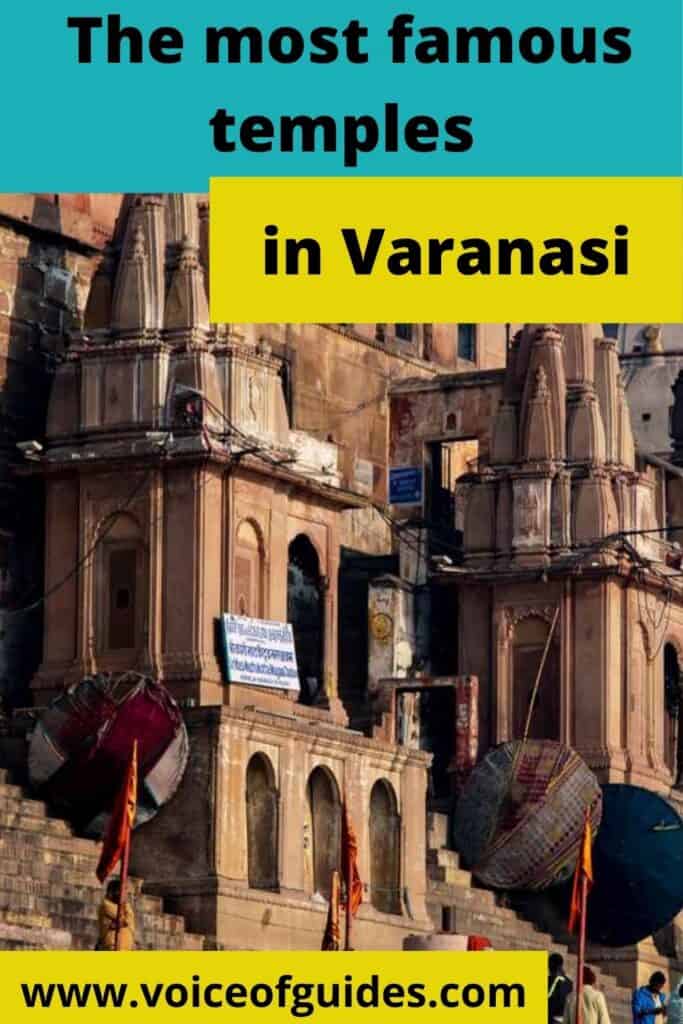
Shiva is one of the three principal Hindu Gods (Brahma, Vishnu, and Shiva) whose incarnations make up the approximately 330 million Gods and Goddesses of the Hindu pantheon. Lord Shiva was meditating in the Himalayas as an ascetic, who descended to earth to help if the demons tried to endanger the regular life.
When Shiva married Parvati, daughter of the Himalayas, he needed to find a suitable home for the two of them. He chose from all the places on earth, Varanasi.
But Kashi stood that time under the rule of king Divodasha. After several attempts to get rid of the king, Vishnu came as last and declared to the king that the city belonged to Shiva. He successfully persuaded Divodasha to leave, who moved to the South. Shiva was extremely grateful for Vishnu to arrange to regain the city for them. Shiva told Vishnu that the Kashi would now belong to both of them. For that, Vishnu also has a strong presence.
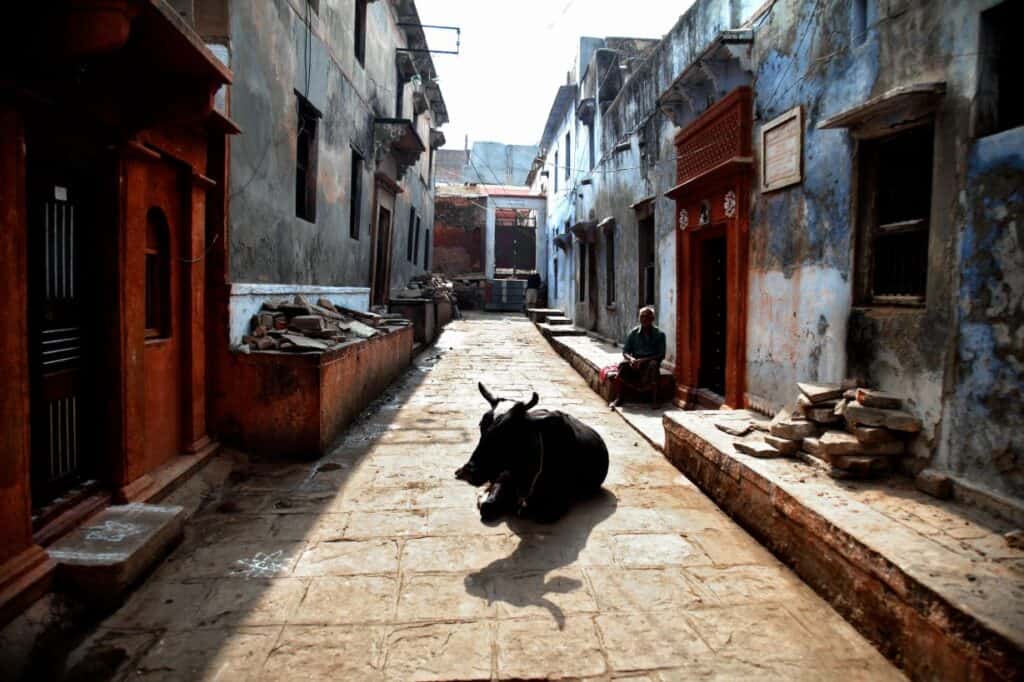
Shiva is the god of ambiguous nature. He has three eyes, and the one in the middle can eject fire to destroy the devil when needed. Hindus venerate Shiva in two forms. Either in a human body or the form of a „lingam”. As a human, he wears snakes around his neck and in the locks of his hair. Tigerskin is wrapped around her waist and has a trident in his hand.
But Shiva is the only god that the devotees mostly venerate in the form of a lingam, rounded vertical shaft of stone. The lingam means „phallus”. But in a wider sense, it is the symbol of the wholeness of the Hindu universe.
The myth of the Jyotirlinga (the pillar of shine)
There is one focal Hindu mythological story that you must know before visiting the temples in Varanasi.
Gods Brahma and Vishnu were arguing about which one of them enjoys supremacy over the other. According to their general role, Brahma is the creator of the Universe while Vishnu maintains harmony on earth. To end the dispute, Lord Shiva turned up as a mediator. He took the shape of a towering shiny pillar (Jyotirlinga) that split the earth between Brahma and Vishnu and pierced even the highest heavens. Shiva said, whoever finds the tip of the light will be the Supreme God. Brahma mounted his goose to fly to the sky, while Vishnu dug to the bottom as a boar. But even thousands of years later, neither could find the bottom or the top of the light. Brahma tried to cheat to win the competition by presenting a flower as a false witness.
Shiva got angry at Brahma and decided to punish him. Shiva cursed Brahma not to be worshipped in his life and blessed Vishnu with eternal worship. Besides, Shiva created his most ferocious form, Bhairava, who cut off one of Brahma’s five heads. That is why Brahma became four-headed. The decapitated head of Brahma stuck to the hand of Bhairava, who committed the worst sin to kill a Brahmin. Bhairava wandered through the land and used this skull as a begging bowl for his food. When he entered Kashi, it dropped, and Brahma immediately got liberated from his sins. From that day, Bhairava stayed at Kashi forever to protect devotees from their problems.
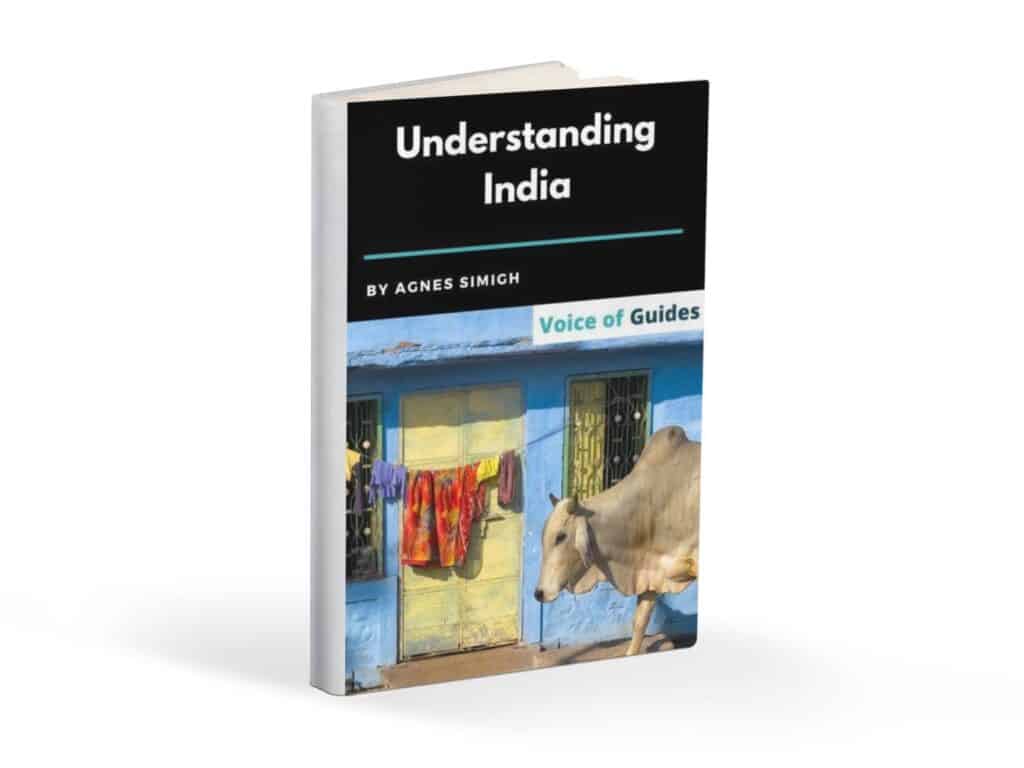
The Shiva lingam
The lingam of light was the first lingam. The lingam that Hindus worship as a symbol of Shiva is a smaller “phallus-shaped” structure. Many times instead of human representation, only the lingam stands in the inner sanctum. Altogether there are 12 holiest Shiva temples (jyotirlingas) in India where Shiva appeared as a pillar of light. Three lingams claimed to be the lingam of light; in the temples of Omkāreshvara, Avimukteshvara, and Vishveshvara.
And they say there are 100 000 lingams in Varanasi itself. Some lingams emerged miraculously from the earth. Other lingams were created by sages, priests and people. By consecrating them, Shiva gets invited to take up residence in them.
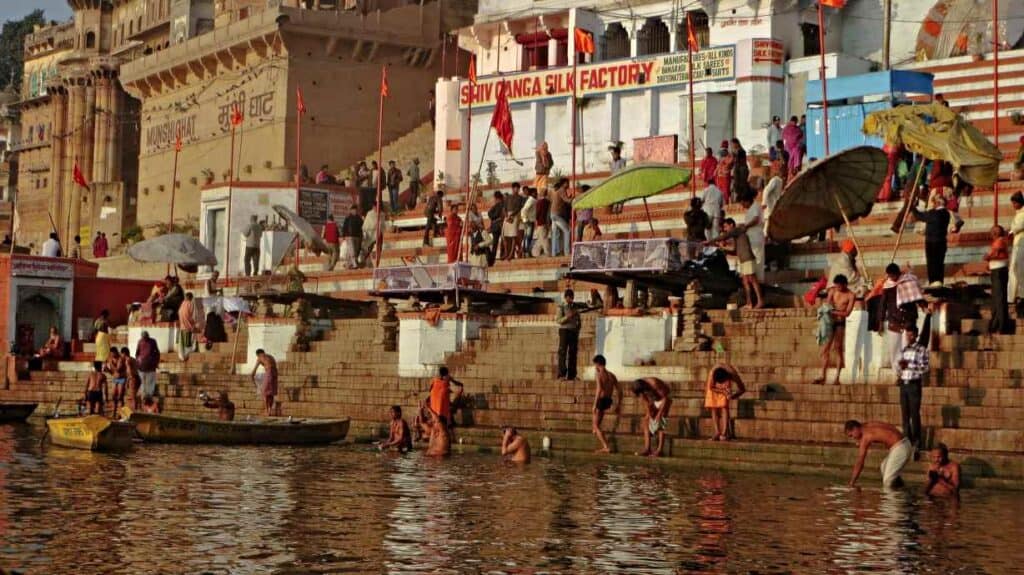
The most famous temples in Varanasi
Kashi Vishwanath – no pilgrim leaves Banaras without going to the Golden temple
The name of the temple means the “Lord of the universe”. The lingam of the Vishwanath temple is one of the most important in all India. Despite its significance, it is simple compared to other iconic religious places. It is neither spacious nor elaborate. But the power of religious devotion is astonishing, and this temple is a key to understand Varanasi. Some say Shiva himself lived in the temple. Thousands of devotees come to visit the temple every day from all over the world. It is one of the 12 holiest Shiva temples (jyotirlingas) in India (where Shiva appeared as a pillar of light)
The Inner Sanctum with the black stone lingam in a silver altar is only accessible to Hindus.
The Visvanath Gali (Lane) is full of shops selling silks, brassware, betel nuts, and religious things (lingams, oil lamps, rosaries, incense, garlands, and sweets) to offer to the gods.
A temple stands for a minimum of 1000 years on this spot. Queen Ahalyabai Holkar of Indore ordered to build the current one in 1776-1777. As most of the temples in Varanasi, it was demolished several times by the Muslim Afghan rulers and the Moghul Emperor, Aurangzeb, who built a mosque at its place. They covered the dome and a spire of the temple with 800 kg golden folia thanks to the donations of the Sikh Maharaja, Ranjit Singh. Hence the other name, the Golden temple.
Every pilgrim comes for “Darshana”, to worship Lord Shiva in the Viswanath temple. Despite the jostling crowds, the loud bell clanging, shouting, it is an extraordinary divine place.
Apart from Lord Shiva, the temple contains the image of the Hindu Gods, Vishnu and Ganesha.
The well of wisdom and the Gyanvapi mosque
When news spread that the bigot Mughal ruler, Aurangzeb, plans to destroy the temple, a holy saint took the idol of Shiva in his hand and jumped into the well to protect it from the invaders. The well between the mosque and the temple is now protected with iron bars to prevent the occasional suicides of liberation seekers.
You can still spot the ornate wall of the old Hindu temple that Aurangzeb built into the Gyanvapi Mosque. Strangely, Hindu religious activities are performed all around the mosque. Ironically, he even named it after the well of wisdom of the former temple.
The direct proximity of a mosque and a Hindu temple makes it a tense area. In 1809, it came to violent clashes when the Hindus wanted to erect a shrine on the neutral ground between the Gyanvapi Mosque and the Vishvanath temple. By an unfortunate coincidence, the Hindu Holi and the Muharram Muslim festivals occurred at the same time. When the processions of the two religions crossed each other, tension turned into a violent clash. Both sides desecrated the other. The Muslims slaughtered a holy cow on one of the great Ghats, and its blood ran into the Holy Ganges. The Hindus destroyed a mosque and threatened to attack all the mosques in the city. The riots demanded several lives until the British administration quelled it.
How to plan your trip to India
Book your flight ticket to India: I always use Google Flights, Skyscanner or Wayaway to find the cheapest flight tickets worldwide. To get an extra 10% for your Wayaway Membership Plus program use my discount code VOG
Insurance to India: Safetywing is an affordable insurance that covers COVID-related issues as well.
: Book your train, bus and domestic ticket in India:
Check Indian Railways website for train tickers, or 12Go which gives you the best option (train, bus, and flight) based on the city of departure or arrival.
Book accommodation in India: Booking.com and Hostelworld.com offer a wide choice of low and higher-budget hotels.
Local tours and tour packages: Viator and GetYourGuide offer transfers and several one or multi-day tours.
The mosques built by demolishing Hindu temples create constant debates, and tension erupted in the 1990s. In 1992, a group of Hindus attacked the Babri mosque in Ayodhya built on the spot where Lord Rama was born, and once a Hindu temple stood. There was a fear that it spreads all over the country. About a thousand policemen were deployed to prevent a similar incident at the Gyanvapi mosque.
The Vishwanath- Gyanvapi area remains disputed. Prime Minister Modi announced to build a pathway connecting the Vishwanath temple to the river Ganga. He ordered to demolish part of the surrounding of the mosque. As Muslims protested, he consented to rebuild the demolished parts. Earlier, Hindus tried to hide the statue of Nandi, the carrier animal of Lord Shiva, as a piece of evidence that there was a Hindu temple under the mosque.
More on that: https://electionfacts.in/2019/12/latest/after-ayodhya-dispute-gyanvapi-mosque-trial-to-be-heard-in-court/
There are other Vishwanath temples in Varanasi:
Orthodox Brahmins established a New Visvanatha temple at the Mir Ghat because they thought that the old one got impure when the “untouchables” got access after 1956. Mahatma Gandhi spoke up for the discrimination of the “untouchables” (people from lower caste). He demanded that they should not be excluded from temples, schools, and any public places anymore.
One of the wealthiest Indian families, the Birlas built another Viswanath temple at the (Banaras Hindu University) BHU.
Important things to know about the visit to the Golden temple
- There is a strict security control to enter the temple. Mobile, camera, cigarette, lighter, metal objects, alcohol, women bags are not allowed. You can deposit the camera and cell phone in a locker.
- Only Hindus are allowed to enter the inner sanctum for „Darshana”. Foreigners can enter the temple if they register in advance at the Temple Authority by presenting a copy of their passports.
- Take special care to dress up modestly. There are plans to introduce a dress code. If accepted, women would have to wear a Saari, while men have to wear dhoti to enter the temple. If foreigners show up in overly modern clothes, the guards can deny their access.
- Due to the constant crowd, take care of your belongings!
- The temple has several exits and entrances, and it is easy to lose your orientation. Do not forget to memorize the gate you entered.
- For Hindus: There is always a queue to see the main deity. Expect to wait 30-60 minutes. For an extra 500 INR, you can get priority access. Or you can book the visit online (350-400 INR online).
- Nobody can touch the deity.
- Beware of fake priests inside the temple complex who promise to quickly take you to the sanctum for a small amount of money. To avoid any issues, it is better if you book your visit online.
Entrance fee: free of cost, but you should leave some donation. If you buy the ticket online, you can avoid the queue (only available for Hindus). Depending on the aarti, the ticket prices vary between 350-400 INR.
Location: The Kashi Vishwanath temple is on the western bank of the holy river Ganges, almost 5 km away from the Varanasi railway station and 6 km from the BHU.
Time of Aarti ceremony:
- Mangla: 3:00 am – Four Brahmins wake up Lord Shiva
- Bhoga: 11:30 am – 12: 30 pm
- Saptrishi: 7:00 pm – 8:00 pm – Seven Brahmins perform the ceremony
- Shringar/Bhog: 8:00 pm-9:00 pm – The most specific aarti includes Vedic rituals for worshiping the Lord as King of Kashi
- Shayan: 10:30 pm – 11:00 pm
Annapurna temple
Opposite the Vishwanath temple stands the Annapurna temple dedicated to the Goddess of food and nourishment.
On the eighth day of the autumn and spring Navarātra (“Nine Nights”) festival, thousands of devotees come to circumambulate the shrine. Some circle this sanctum an auspicious 108 times.
The temple contains two icons of the Goddess: gold and brass. They expose the brass image during the daily Darshan (worship).
But devotees can only see the gold image during three days of the Annakut festival. The Darshana of the golden image of Annapurna is one of the primordial events of Varanasi.
They build mountains of food inside the temple from rice, lentil, and other staples. They will distribute it as „prasad”(offering) to the devotees who come to visit the temple. During Annakut, they distribute coins among the devotees. Those who worship the coins would be blessed by prosperous and successful life thanks to Goddess Annapurna.
Every day at noon, the temple offers food for every old, disabled, and other devotees as „Prashad” who come by.
Opening time: 4:00 am- 11:30 am and 7:00 pm-11:00 pm.
Aarti time is: 4:00 am
Location: next to Vishwanath temple
Durga temple – the red-colored Monkey temple
Another famous temple in Varanasi is dedicated to Durga Hindu Goddess, who cruelly defeated the demons and devils. Durga rides a lion or a tiger and keeps sword, spear, and the trident of Shiva, or the discos of Vishnu in her hand. According to local belief, the idol of Durga inside the sanctum is not manmade, but the Goddess itself appeared in the form of a statue. A maharani from Bengal instructed to build the temple in a unique North-Indian, Nagara-style with layered roof in the 18th century. The temple stands next to the rectangular water tank, the Durga Kund. The small lakes (kunds) are also considered holy places where people come for ritual bathing.
Since the idol of Durga is dressed in red, they painted the temple in the same color. Banarasiis believe that Varanasi is under the protection of Durga. Due to the hordes of monkeys, people also call it the Monkey Temple.
The auspicious days to worship Durga are Tuesdays and Saturdays. On those evenings, her temple gets crowded with those who have come for Darshana.
On Tuesdays during the monsoon month of Shravana, thousands make their pilgrimage to Durga. It is one of the most illustrious fairs of Kashi, and the whole area around the temple becomes a center for amusement.
Opening hours: 7:00 am – 8:00 pm
Location: just 250 meters north of Tulsi Manas Mandir, 700 meters north-east of Sankat Mochan Mandir, and 1.3 kilometers north of Banaras Hindu University. The Durga temple stands in a modern residential suburb of the middle- and upper-class of Varanasi.
Important for your visit: Only Hindus can enter the main sanctum, and no mobile and camera are allowed.
Nepali Mandir – the replica of the Pashupatinath temple of Kathmandu
The king of Nepal built the Lalita Ghat and the mandir (shrine) in the 19th century. People believe that by coming for a ritual bath at the Ghat dedicated to Lalita Devi, the personification of Goddess Durga, they earn her blessing. According to local belief, the Darshana of Lalita Deva brings the same rewards as circumambulating the whole world!
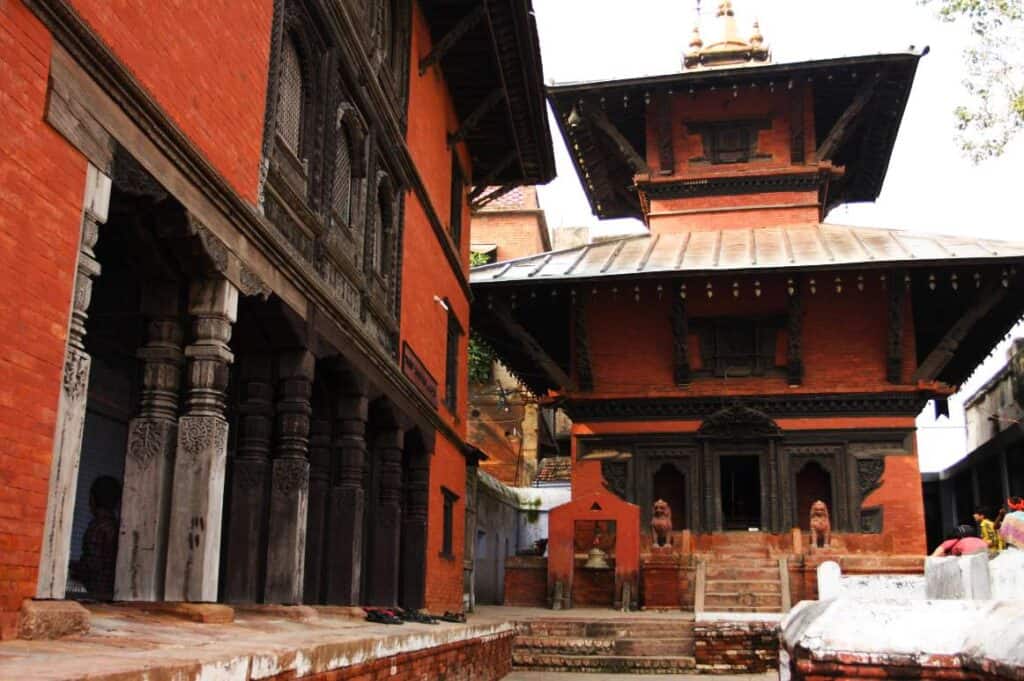
The Nepali king was in exile from 1800 to 1804 and ordered to build the replica of the Pashupatinath temple of Kathmandu in Varanasi as a sign of his gratitude. He moved back to Nepal before he could finish the temple. Two years later, he was stabbed to death by his brother, and his son completed it after 20 years. They constructed the temple mainly of wood in a pagoda-style following Nepali architecture.
They also call the temple “Mini Khajuraho” because of the erotic sculptures similar to ones in the Khajuraho.
Entrance Fee: 20 INR
Opening hours: 4:00 am – 9:00 pm
Location: 100 meters South-West of Manikarnika Ghat
Adi Keshava – alleged to be the oldest temple in Varanasi
They built this temple on the spot where Vishnu, also called Keshava, first set foot when he arrived in Kashi (Adi means starting). It stands at the confluence of the Ganges and Varana rivers on the Raj Ghat (Adi Keshava Ghat). After he bathed, Vishnu made a jet-black four-armed image of himself that is now in the center of the Sanctum. Some say the temple has a 4000-yer history making it the oldest temple in Kashi.
The pleasant surroundings of the temple overlooking two rivers amid a grove of trees make it one of the most peaceful temples of Kashi.
Bindu Madhava temple
Bindu Madhava is another name of Vishnu and means “Drop of Krishna.” Varanasi is the abode of Shiva, and the city stays on the trident of Shiva, but Vishnu and other Hindu Gods are also a significant part of the history of Kashi. This house-like temple does not attract a mass of pilgrims. Vishnu constructed the temple after having taken a bath at the Panchanganga Ghat. It shared the fate of many other Hindu temples. It was the most impressive building along the riverfront until the Mughal Emperor, Aurangzeb, destroyed it in 1669. He used the pillars to build the nearby Amalgir mosque with huge minarets at its place. They kept the statue of Vishnu under the water for several years (1669- 1672) to keep it safe from invaders.
Chatrapati Shivaji, the Maratha ruler, rebuilt the Bindu Madhava temple in 1672 next to the great mosque of Aurangzeb.
The temple gets busy during the month of Kartika (October-November). Devotees place oil lamps on the Ganga water and bath at the Panchaganga Ghat before sunrise and after sunset for the liberation of their ancestors.
Entrance fee: free of cost
Opening hours: 5:00 am-12:00 pm, 4:00 am-7:00 pm
Alamgir mosque
The monumental Amalgir mosque towers on the top of the Panchaganga Ghat and dominates the skyline of Varanasi. Once, with the 50-meter-high minarets, it was even more impressive. In 1948, one of the minarets collapsed and killed a few people around. Later, the government pulled down the other minaret due to security reasons.
A stunning view of the Ghats and the river Ganga welcomes you from the top of the steep stairs.
Kala Bhairava – the temple of the “police chief” of Varanasi
Bhairava is popularly known as the police chief of sacred Kashi. He is the most fearsome form of Lord Shiva, and even the death if afraid of him. He controls who enters and leaves Varanasi. Even the Gods can only stay in Kashi with his permission. Bhairava not only scrutinizes the activities of the living but also brings justice to those who have died. If he gets angry, the person cannot leave Varanasi for his entire life.
For many centuries, this temple was a spiritual center for the most rigid Shaiva ascetics and a mandatory stop for pilgrims. Now only a few pilgrims make the extra effort to come here. They go for “Darshana” to the Vishvanatha and Annapurna temple instead.
The modern Kala Bhairava temple was built in the 19th century.
The celestial vehicle of the Hindu God, a dog guards the temple door. The main shire stands in the center of the courtyard.
Kala Bhairava (mentioned in the myth of the Jyotirlinga, the pillar of shine) walked around the world with the head of God Brahma in his hand. When he entered Kashi, it dropped to the ground, and his sins for killing a Brahmin got washed away. From that day onwards, Bhairava stayed in Kashi to protect the devotees from their problems. Bhairava is none other than the manifestation of Shiva’s terrible face. There are more Bhairavas, but Kala Bhairava is the most important of all of them. Kala also took over the duty of the God of Death in Kashi.
Kala Bhairava usually has a mustache, wears a garland of human skulls, and holds a peacock feather in his hand. He is depicted with a silver mask in the Kala Bhairava temple. They hid the rest of Bhairava’s image with a cloth drapery, but we can imagine that he is seated upon a dog and holds a trident.
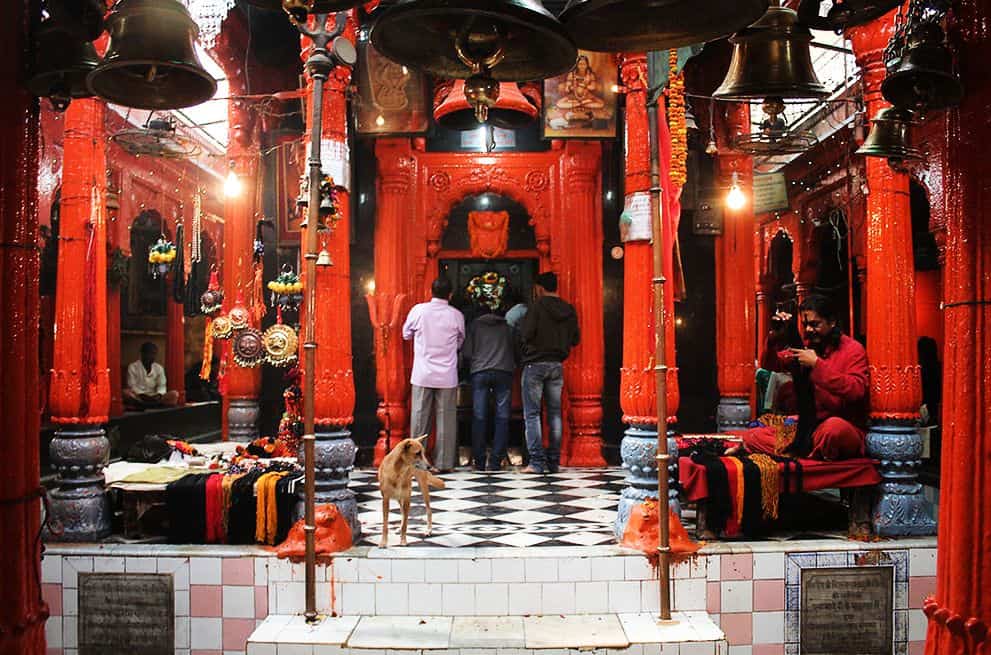
Around the temple, there are a series of subsidiary shrines to Devi, to Hanuman, to Krishna and Radha, to Parvati and Ganesha.
The holy men sitting around the temple dust off the sins from worshippers. It also helps to keep the pain and sickness away.
Eight days after full moon day in November is an auspicious day when priests perform numerous rituals in the temple. Sundays and Tuesdays are the days to worship the deity. It also gets very crowded during Annakut (the fourth day from Diwali).
Entrance fee: free of cost
Opening time of the temple is: 5:00 am-1:30 pm and 4:30 pm-9:30 pm.
Location: 10 minutes from the Kashi Vishwanath temple with a cab or auto-rickshaw.
Tulsi Manas temple – the Rama temple of Varanasi
The white-marble Tulsi Manas from the 20th century is the largest temple in the city besides the New Temple at the Banaras Hindu University. Tulsi Das was a great poet in Varanasi in the 16th century. Instead of the ancient Sanskrit, only spoken by the priests and pandits, he decided to write in Hindi, the mother tongue of the people. Despite numerous critics from pandits, he remained true to his idea.
He was a fervent devotee of Hanuman, the monkey-servant of Lord Rahma. Tulsi Das started the Hanuman cult in the country by writing the Hindi version of the famous epic, the Ramayana.
Ever since Hanuman is one of the most beloved Hindu gods. The Ramayana is the mythological story of King Rama, who went to fight the Ravana, the demon on Lanka Island, and freed Sita with his faithful servant, Hanuman. The entire text is engraved in the marble slabs on the interior walls of the temple.
Tulsi Das wrote the epic where the temple stands today, and the statue of all Gods and Goddesses from the story are present in the temple. The pleasant Tulsi garden attached to the temple is a perfect place to walk around. The second floor of the temple has statues and scenes of the great Hindu legends from the Ramayana and Mahabharata Indian epics.
Every year during the “Ram Lila” festival, they recall the story of King Rama.
Tulsi Das is said to have stayed at multiple places in Banaras in the heart of the city, including the Asi Ghat. That Ghat is now called Tulsi Ghat. His house right next to the river still exists, and they keep the sandals of the great poet inside. Tulsi Das died in 1623 at the age of eighty, and they sprayed his ashes into the Ganges.
Opening Time of the Temple is: 5:30 am to 12:00 pm and 3:30 pm to 9:00 pm.
Aarti time is: 6:00 am and 4:00 pm.
Locations: Close to Durga temple
Sankat Mochan – a beloved Hanuman temple
It is one of the three most important temples in the eyes of most Banarasi after Vishwanath and Annapurna. Sankat „means problem”, Mochan means „relief giver” which means that visiting the temple will remove all your problems.
The freedom fighter Pandit Madan Mohan Malviya (the founder of the BHU) founded the temple in the early 1900s at the location where Tulsi Das, the enthusiastic devotee of Hanuman, had a vision.
The devotees usually offer a special sweet sold around the temple, the “besan ke ladoo” with garlands to God. According to the Hindu mythology, Hanuman was the servant of Lord Rama, but here he faces Rama.
On 7th March 2006, three explosions struck the temple. All that happened when an aarti was going on with several worshippers. But the devotees showed strength, and they filled the temple the day after. Since the terrorist attack in 2007, there has been permanent police security.
The Sangeet Samaroh dance and music festival takes place every year in the temple in April. Celebrated performs from all over India attract big crowds for the famous celebration.
Tuesday and Saturday are the best days to offer pooja to the Lord Hanuman when thousands of devotees come to the temple.
Opening time: 5:00 am – 10:00 pm
Aarti time: 4:00 am (Subah Aarti) and 9:00 pm (Sandhya Aarti)
Location: You can take an auto-rickshaw to Sankat Mochan directly from Banaras railway station, or a bus (15 INR, 45 minutes).
The New Vishwanath temple at the BHU campus
The wealthy Birla industrialist family built the temple inside the university campus but not exclusively for teachers and students in 1965. Everybody is welcome to visit the Shiva temple. It is a copy of the original Vishwanath temple. There are nine temples on the campus.
The tall tower of the temple is striking from a distance. It is taller than the famous Qutub minaret in Delhi.
Plenty of devotees come from India and the world to the temple for its colorful festival rituals. Shivratri, Navratries, Krishna Janmashtami, Shravan Mahotasva, Annakut, Deepawali, and the establishment day of the temple attract immense crowds.
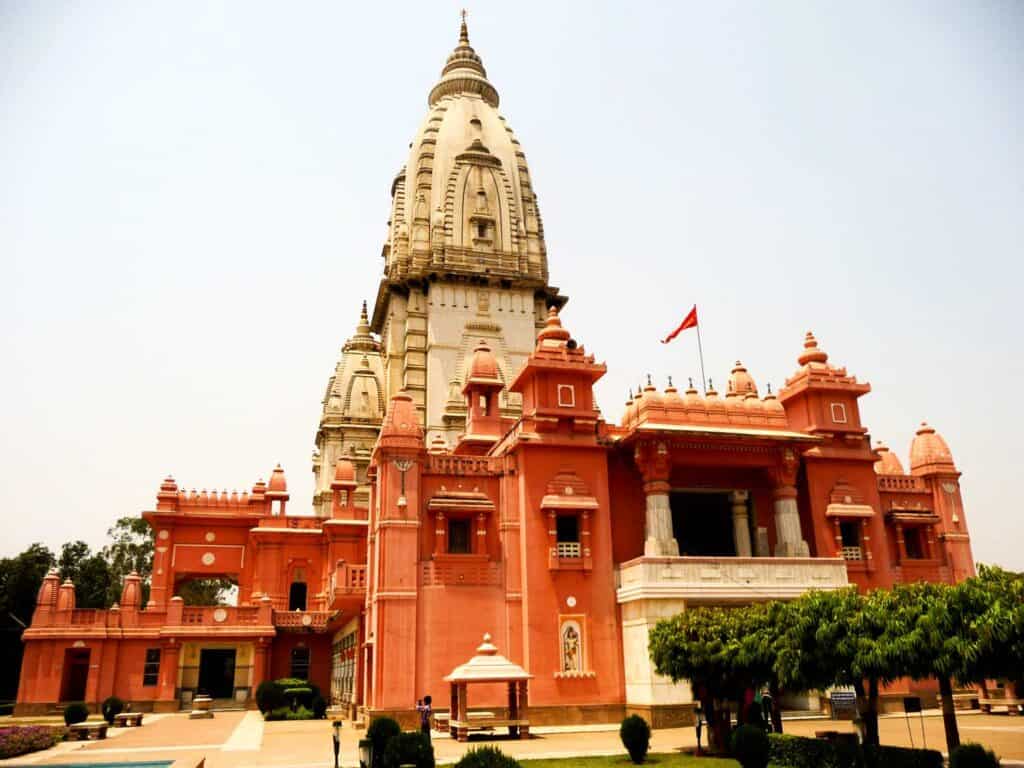
Location: Birla Temple is located in the BHU premises about 7 km from Cantt. Railway Station, Varanasi. Take a cab or auto-rickshaw.
Opening time: 4 am-12 pm and 1 pm-9 pm.
Aarti time: 4:00 am, 4:45 am, 10:30 am, 11:45 am, 12:00 pm, 1:00 pm, 6:45 pm, 7:30 pm, 8:00 pm and 8:45 pm. Every Monday, Rudrabhishek is performed from 7 am to 8 am. Rudra is another name of Shiva, and during this puja, he gets a sacred bath with flowers. It is one of the most important Vedic Hindu rituals to worship Lord Shiva.
Bharat Mata- the Mother India temple
Mahatma Gandhi inaugurated the Bharat Mata temple in 1936. In contrast to other Hindu temples, where statues of Gods and Goddesses are displayed, here the map of India is modeled in white marble before the partition in 1947.
The detailed map displays the mountains, plains, and oceans of India.
The best 2-week itinerary if you are the first time in India including the Golden Traingle
Kedareshwar temple – one of the most sacred places
The Kedareshwar is one of the 12 “pillars of light temples” (Jyothirlinga) in Varanasi. Kedara means “field” and where the crop of liberation grows. After having a ritual bath in the river Ganga at Kedar Ghat, devotees climb the white-red stairs flanked by small shrines with lingams that lead to the temple on the top. Women carry smaller, men bigger brass pots filled with the Ganga water on their shoulders to offer to the God, Kadereshvara.
The otherwise calm temple only gets crowded during Shavrana (July-August) on Monday mornings, on the day of Shiva. It is defintely one of the most famous temples in Varanasi.
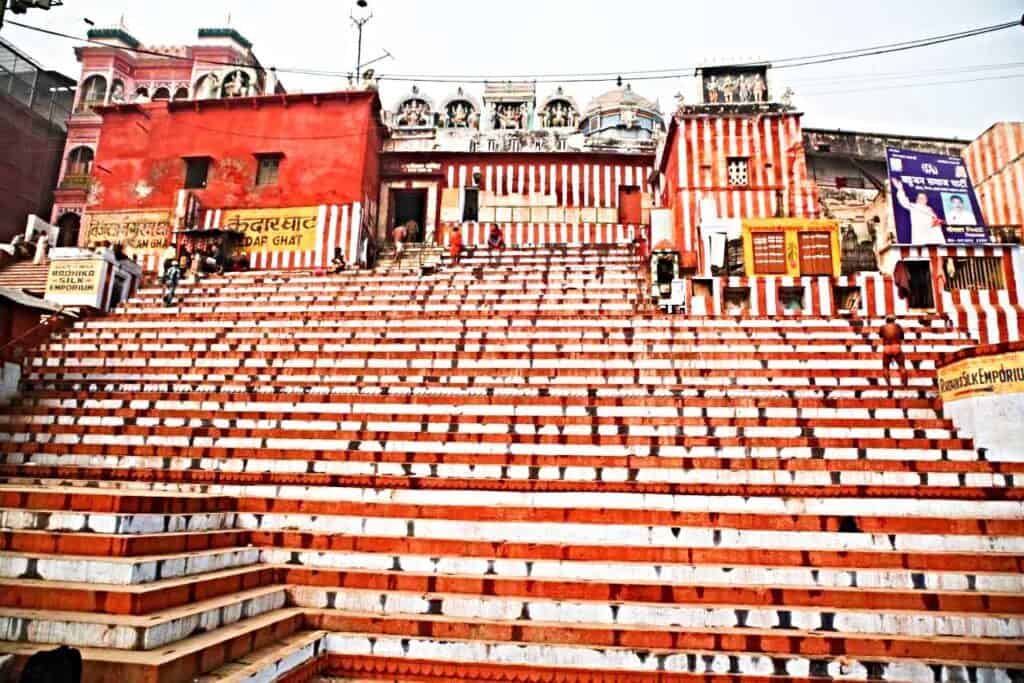
Sankata Devi temple – one of the most powerful temples in the city
Sankata Devi, the „Goddess of Remedy” keeps the danger away from her devotees. The temple stands on the top of the Sankata Ghat. Uniquely, this Goddess has no consort.
Women gather in the temple on Friday mornings to make their offerings, sing devotional songs together. Married women pray for the long life of their husbands, unmarried women to find decent husbands. Boys and girls wish to pass their exams and keep away sickness and accident. These are mostly women’s rites and the leaders of these Friday morning circles are women.
Sankata Devi is an independent female power who has no consort. She has ten hands and the ability to protect faraway husbands and to ensure their safe return.
The Mandir was constructed in the 18th century by the King of Baroda. It is probably the only temple in India dedicated to Sankata Devi.
The eighth day during the Navratri festival is dedicated to Goddess Sankata Devi, also known as “Matrika” (caring mother) by her devotees. The devotees pray to the deity to avoid any danger in life or to alleviate any present crisis.
Opening time: 4 am-11 pm
Location: near the Scindia Ghat
Hope you found the information about the most famous temples of Varanasi useful.
How to plan your trip to India
Book your flight ticket to India: I always use Google Flights, Skyscanner or Wayaway to find the cheapest flight tickets worldwide. To get an extra 10% for your Wayaway Membership Plus program use my discount code VOG
Insurance to India: Safetywing is an affordable insurance that covers COVID-related issues as well.
: Book your train, bus and domestic ticket in India:
Check Indian Railways website for train tickers, or 12Go which gives you the best option (train, bus, and flight) based on the city of departure or arrival.
Book accommodation in India: Booking.com and Hostelworld.com offer a wide choice of low and higher-budget hotels.
Local tours and tour packages: Viator and GetYourGuide offer transfers and several one or multi-day tours.

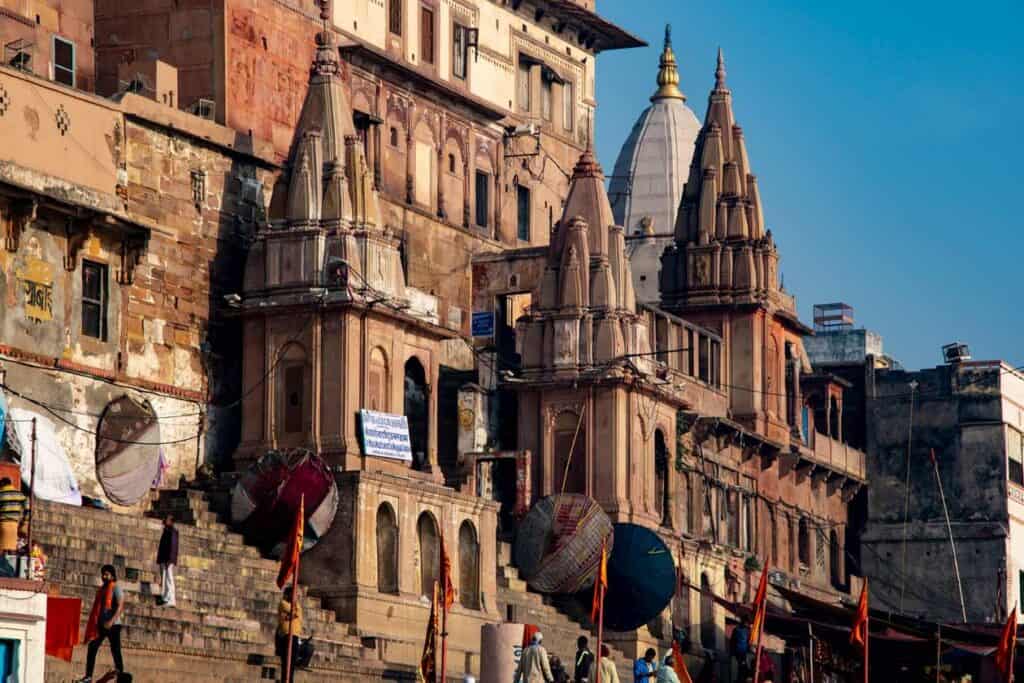

Pingback: The ultimate guide for a two-week itinerary including the Golden Triangle in India | Voice of Guides
Thank you so much for sharing all this wonderful info with the how-to’s! It is so appreciated!”
I’m happy it was useful for you!